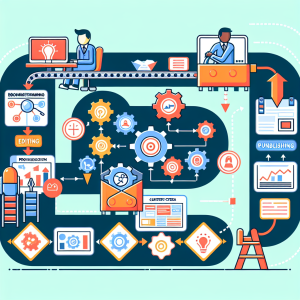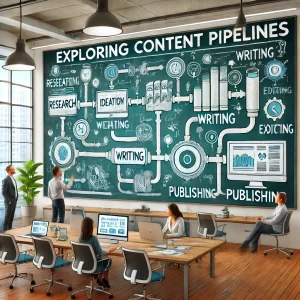
Introduction
Interviewee: Adam Willhoeft – Adam is a renowned expert in data-driven marketing and content pipelines, with over 20 years of experience in the industry. At 1UP Media, he has significantly contributed to optimizing marketing strategies and content workflows.
This interview aims to explore various aspects of data-driven marketing, content pipelines, and workflows, providing insights, tips, and best practices for content creators, managers, and marketing professionals.
Topics covered will include the importance of data-driven strategies, best practices for content management, tools and technologies, and future trends.
Questions and Answers
1. Can you tell us about your background and experiences in the marketing industry?
Adam Willhoeft: Absolutely! My journey began in the realm of data analysis, where I developed a strong foundation in data forensics and auditing. Over the years, I realized the potential of combining data analytics with marketing strategies. This led me to performance marketing, where I’ve had the opportunity to work on large-scale campaigns, manage substantial ad budgets, and optimize for long-term value (LTV) and return on investment (ROI). Utilizing my expertise in psychology and human behavior, I aim to help others and influence data-driven strategies effectively.
2. What are some key milestones in your career?
Adam Willhoeft: Some key milestones include optimizing over $85 million in ad inventory for online campaigns and managing annual advertising budgets exceeding $20 million. Additionally, developing scalable e-commerce business growth strategies using predictive analytics and digital media buying has been a significant achievement. These experiences have solidified my belief in the power of data-driven marketing.
3. How do you see the importance of data-driven strategies in content creation?
Adam Willhoeft: Data-driven strategies are the backbone of effective content creation. By relying on data, we can remove biases and ensure that our content resonates with the target audience. This approach helps in managing resources efficiently and ensures consistent quality. Data provides insights into what works and what doesn’t, allowing us to make informed decisions and focus more on creativity.
4. Could you share some best practices for managing content pipelines?
Adam Willhoeft: Certainly! Establishing clear roles and responsibilities is crucial. Using collaborative tools like Trello for project management and Asana for team collaboration can streamline processes. Maintaining a content calendar ensures everyone is on the same page, and regular monitoring and analyzing performance helps in continuous improvement. Emphasizing adaptability and fostering open communication within the team are also key practices.
5. What tools and technologies do you recommend for optimizing content workflows?
Adam Willhoeft: There are numerous tools available, but some of my favorites include Trello for project management, Grammarly for editing, Canva for design, and Asana for team collaboration. Additionally, using a robust CMS like WordPress, integrated with plugins such as the one developed by 1UP Media, can significantly streamline the publishing process.
6. What challenges have you faced in your career, and how did you overcome them?
Adam Willhoeft: One of the major challenges was managing large-scale content projects with tight deadlines. Implementing agile methodologies and fostering a culture of open communication within the team helped overcome these challenges. Adaptability and continuous learning were key to navigating these hurdles.
7. What are the latest trends in data-driven marketing and content pipeline management?
Adam Willhoeft: Personalization at scale, leveraging AI for content generation, real-time analytics, and integrating content with broader marketing goals are some of the latest trends. These innovations help in delivering more targeted and effective content, enhancing overall marketing strategies. Read more about how these trends are shaping the industry.
8. What is your vision for the future of content pipelines?
Adam Willhoeft: I foresee a more integrated and automated future where AI plays a crucial role in content generation and management. There will be a stronger focus on personalization and data-driven insights to tailor content more effectively to audience needs. Automation will streamline workflows, allowing teams to focus more on strategy and creativity.
9. How do you ensure sustainability and scalability in content pipelines?
Adam Willhoeft: By using scalable tools, maintaining a flexible approach, and continuously refining processes based on analytics and feedback, sustainability can be achieved. It’s also important to build a team culture that values innovation and adaptability. Leveraging data-driven insights ensures that content strategies remain effective and relevant.
10. Do you have any advice for aspiring content creators and managers?
Adam Willhoeft: Stay curious, keep learning, and embrace new technologies. Building a strong foundation in content fundamentals while staying adaptable to new trends will help you succeed in this ever-evolving field. Always let data guide your actions and decisions.
Conclusion
This interview with Adam Willhoeft provides valuable insights into the world of data-driven marketing and content pipelines. Key takeaways include the significance of data-driven strategies, best practices for content management, and the impact of technology and innovation on content creation processes. For those looking to delve deeper into content management strategies, you can follow Adam Willhoeft’s work on his LinkedIn profile and explore more of his contributions to 1UP Media. Click here for more detailed insights.
Thank you, Adam, for sharing your expertise and time with us!
Related Posts:
Interview with Jane Doe on Content Pipelines and Workflows (93.77% match)
Exploring Content Pipelines: Insights from Adam Willhoeft (93.42% match)
Optimizing Content Pipelines: Strategies and Results (89.88% match)





No comment yet, add your voice below!